Nose reshaping is the most common service provided by plastic surgeons. Many also always perceive a small defect in the nose as a tragedy. But it can be difficult to decide on a surgery - rhinoplasty. Modern aesthetic medicine offers an innovative way to overcome shortcomings. In the presence of minor defects, non-surgical rhinoplasty can improve the appearance and make the face symmetrical.
Types of rhinoplasty
In plastic surgery, several types of rhinoplasty are usually distinguished according to the technique and goals of the surgery.
All types of operations are primary and secondary (repeated) and can be:
- Reconstructive. This group includes manipulations to repair anatomical abnormalities that result from inadequate intrauterine development or traumatic injuries or diseases.
- Aesthetics. Its purpose is to correct deficiencies.
There are several types of rhinoplasty to treat:
- Reduction. Provides a reduction in the size of the osteochondral frame of the nose. These may include shortening of the apex, narrowing of the bridge of the nose, width of the nostrils, and lateral cartilage.
- Enhancement. Its purpose is to correct defects by increasing the size of the nasal frame. It is also used for secondary plastics.
- Receptor chinoplasty. Eliminate the curvature of the nasal septum to facilitate nasal breathing, including solving the problem of snoring.
- Vaccination. The required shape of the nose is created from the cartilage tissue of the patient. The cartilage of the auricle and nasal septum can be taken for transplantation.
- Reconstructive rhinoplasty. Its purpose is to correct the results of previous operations.
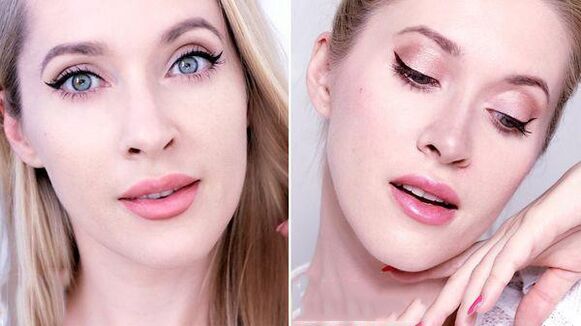
The purpose of the procedure may also be a separate hypertrophic nasal mucosa, columella (bridge between the nostrils). Changing the shape of the tip of the nose (removing the hook or upside down) is a separate and most difficult type of surgery.
For any correction, the surgeon can choose the type of surgical or non-surgical procedure.
Operating room
It is performed under general anesthesia. The operation can take up to several hours and the result will last for many years. Prior to surgery, the patient must sign a written consent for surgery, so he or she must carefully weigh the pros and cons and strictly follow the rules of preoperative preparation, which include:
- delivery of blood tests, fluorography, electrocardiogram;
- consultation with a doctor in other fields (dermatologist, therapist, psychiatrist);
- adherence to diet.
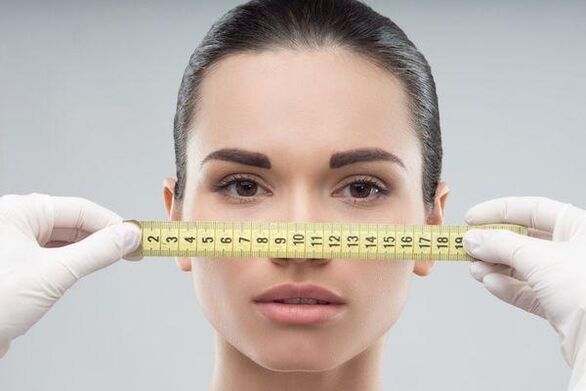
After surgery, the patient is hospitalized for several days under the supervision of medical staff. After the discharge, you must strictly follow some rules and restrictions.
Like all surgeries, nasal correction surgery has many contraindications and can cause side effects and complications.
It's not surgical
Alternatively, non-surgical plastic is used. Contour surgery is minimally invasive and does not involve surgery. It allows you to correct asymmetry, slightly reduce the tip, remove the hump, straighten the nose, but it is not suitable for solving complex problems (restoring respiratory function, eliminating congenital defects).
It differs from classic rhinoplasty:
- lack of complex surgery and long rehabilitation period;
- speed of execution;
- short duration of effect (up to one year);
- the possibility of losing the result.
This can be injectable plastic fillers, hyaluronic acid-based gels, hormonal disintegration drugs, or non-injection correction sutures or rails.
At the cost of contour rhinoplasty is thousands of rubles cheaper than traditional.
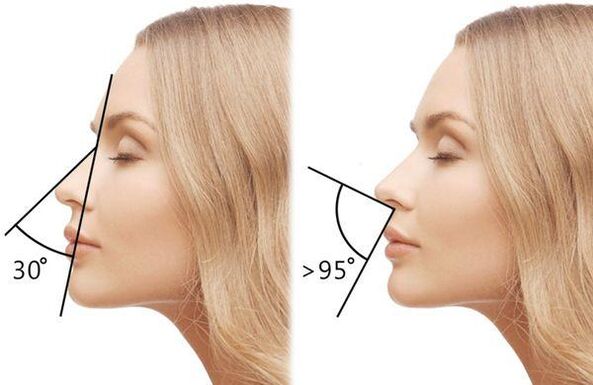
Functional rhinoplasty classifications
Primary total rhinoplasty does not involve a whole nose correction procedure. This is the most popular type of surgery. Conditionally, the indications for surgery can be divided into 2 types, according to which the following is performed:
Cosmetic plastic. If you want to get rid of the following nose problems:
- bumps;
- too long;
- thickened nose (potatoes);
- saddle;
- large nostrils.
Functional plastic. Its purpose is to eliminate the defects that lead to bad breathing, it interferes with the entry of air into the nose:
- curved damaged septum;
- Nasal constriction (birth defect)
- congenital imperfections of cartilage tissue.
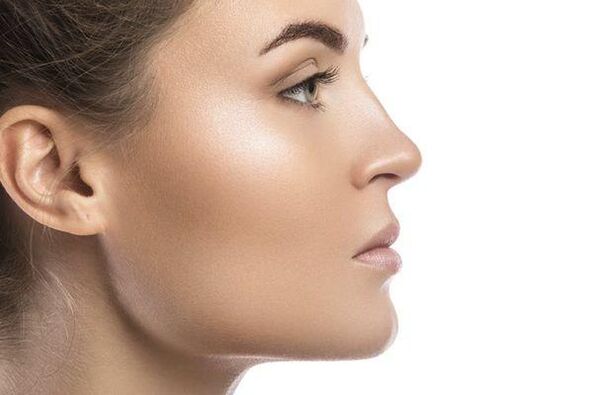
Open
The technique is used in cases where the designated task cannot be accomplished in a closed manner. The incision is made along the columella (the part of the skin between the wrinkles between the nostrils) and the wings of the nose where it is attached to the lips. Open rhinoplasty allows soft tissues and cartilage to be lifted upwards, access to the internal parts for manipulation. Technically complex and large-scale operations require:
- severe deformity of the nose, including lateral displacement;
- a combination of nasal deformity with developmental abnormalities ("cleft lip" or cleft palate);
- reconstruction in which grafts are used.
Disadvantages of this intervention include damage to the arteries of the columella, formation of a postoperative scar, and persistent postoperative tissue edema.
Rhinoplasty is performed only in an open manner. Correcting the shortcomings of primary plastics is a difficult task, so an uncompromising aesthetic result is not always guaranteed.
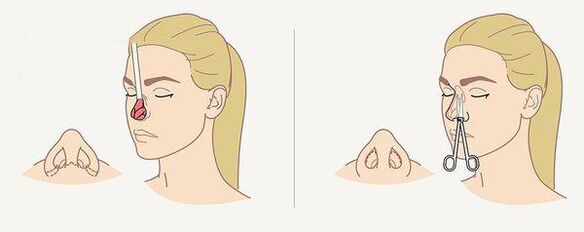
Closed
The method is less traumatic than the open one. The incision is made from the inside, on the mucosa of the vestibule of the nose. Such access is performed when a small volume operation needs to be performed. This type of intervention is marginal (along the inner surfaces of the wings of the nose), transeptal, inter-, and transchondral. Closed access using endoscopic rhinoplasty microinstruments.
It makes it possible to rule out arterial damage and tissue malnutrition, scars after surgery are not visible because they are located in the nasal cavity, the outer part of the skin does not change. The method is often used for aesthetic operations.
Laser
An operation in which a laser is used instead of a scalpel to cut tissue. Laser incision is more gentle because parallel cauterization of blood vessels precludes the development of bleeding.
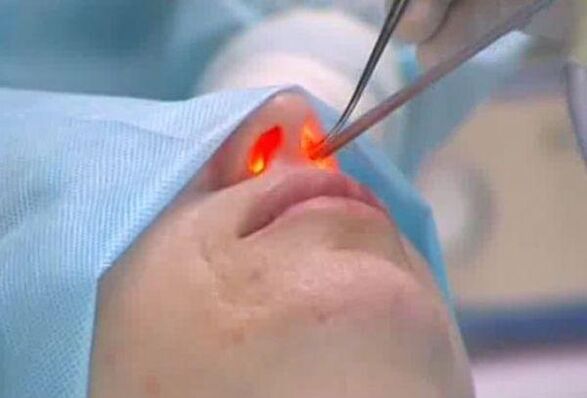
There are two types of laser rhinoplasty:
- open, which involves dissecting the tissues before modeling the soft part or cartilaginous base;
- superficial - they do not make skin incisions, but evaporate the surface layers to correct small changes in the tissues of the nose.
Injection reconstructive rhinoplasty
Sometimes those who undergo rhinoplasty surgery not only want to predict and develop the model, but also want to see the end result. The procedure of contour injection rhinoplasty can help in this. The result is faster, more convenient and cheaper.
You can inject the drug more than once. In some cases, fibrous tissue forms at the injection site and the nose may develop for a long time.
Hyaluronic acid injections
The effect of hyaluronic acid injections lasts for about six months. The introduction of drugs allows the skin surface to be leveled and the nose to be made symmetrical, small irregularities being filled. Hyaluronic acid-based fillers are used in aesthetic surgery. These bases are classified as biodegradable, i. e. , soluble. Over time, the drug breaks down into safe ingredients - water and carbon dioxide.
Plastic nose pads
There are several groups of fillers. Biodegradable, in addition to the above:
- based on animal collagen;
- collagen of human origin;
- calcium hydroxyapatitone;
- on synthetic lactic acid.
These fillers can have a long lasting effect.
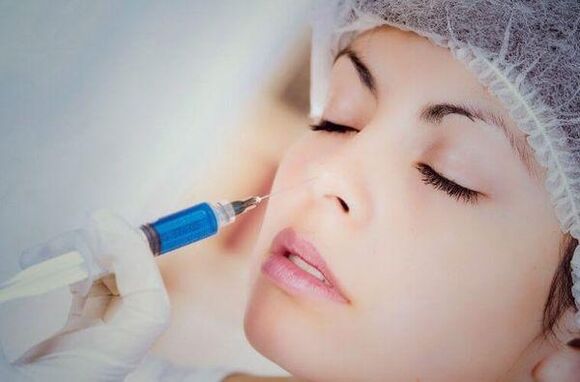
Biodegradable (non-absorbable or permanent) fillers are based on silicone or other synthetic bases (biopolymers). After application, the effect lasts a long time, but experts do not recommend their use. There are several reasons for rejecting synthetic fillers:
- may cause tissue fibrosis;
- it is impossible to remove them from the body;
- it may become an obstacle to the operation of rhinoplasty in the future.
Hormonal drugs
Glucocorticosteroids are used to correct some of the problems in the nose - synthetic substances that are similar to the hormones produced by the human adrenal cortex. They are able to soften and partially dissolve the cartilage tissue, which allows you to correct the shape of the wings and the tip of the nose, smoothing the hump.
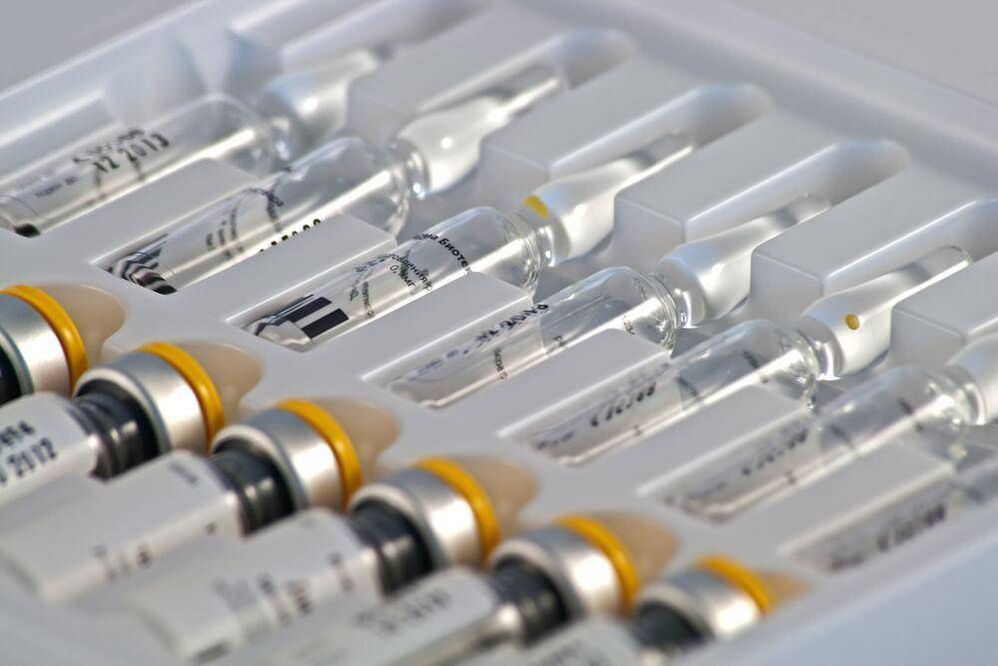
The procedure is relatively simple to perform, but difficult to prepare: the dosage and depth of drug delivery must be calculated very accurately to avoid asymmetry and the formation of unnecessary cavities. In addition, excess hormones can trigger uncontrolled tissue atrophy.
Most often, such a correction is made in several procedures.
Lipolytics
Lipolytics are agents used for meso-injections. It is a biologically active substance that promotes fat burning under the skin. Dermaheal is used to correct the shape of the nose. It helps to remove wrinkles and creases, gets rid of the "fleshy" nose. Contains active ingredients: phosphatidylcholine, hyaluronic acid, carotene and others.
Non-injectable rhinoplasty
More rarely, nose correction is performed without injections. Experts say such procedures are not effective enough.
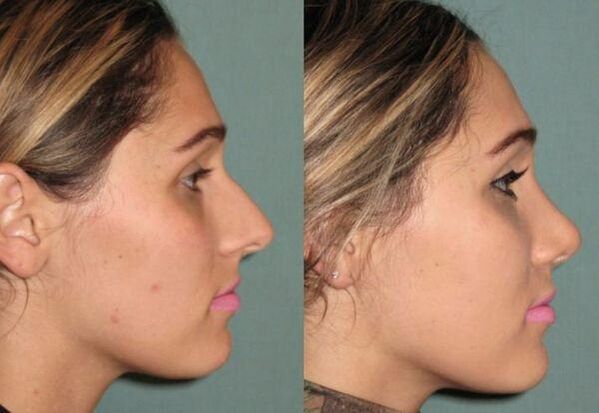
With clinging tongue
To adjust the back and tip of the nose, use a splint - a tool made of plastic or plaster. The design puts constant pressure on cartilage and soft tissues and changes their position over time. You can use a rail to raise the tip, narrow the wings, reduce its length (by raising the tip), smooth the hump, and restore symmetry.
Nowadays, lightweight, removable structures spread in the form of clips or clips. They have to be worn for several months every day.
Threads
To eliminate asymmetry, straighten your back, repair your wings and the tip of your nose, filamentous rhinoplasty is used. Correction technology consists of inserting strong, absorbent fibers under the skin. Unlike fillers, the nose does not visually grow after fiber insertion. The result lasts for 3 years.
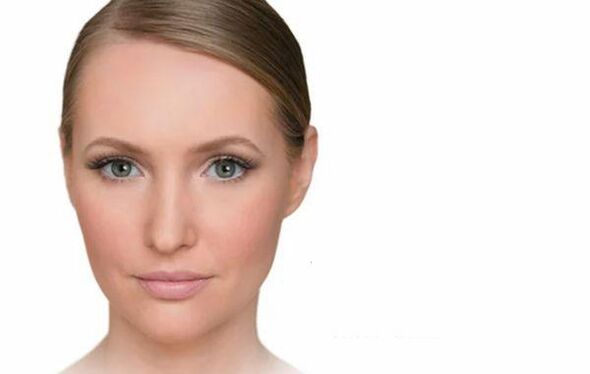
Bion fibers are made of caprolac and fix the tissues of the nasal area through a multitude of grooves. The fibers are inserted through small punctures and then the beautician pulls them and gives the desired shape to the nasal area. The result becomes apparent after 2-3 days. Other benefits of using fibers:
- low invasiveness;
- pain relief;
- application of local anesthesia;
- there are no complications;
- no swelling and bruising.
Disadvantages of the correction method:
- scars may appear at the puncture site;
- the fibers can be contoured, i. e. , visible.
The procedure is contraindicated for those with thin, light skin and those who are prone to the formation of keloid scars.
Indications for use
If the shape and size of the patient’s nose is satisfied, the doctor will most likely prescribe a procedure to him without performing surgical manipulations. When repairing details, you can do it without a scalpel to get rid of:
- nasal asymmetry;
- dents, sags, depressions and irregularities;
- from the drooping tip of the nose;
- from the hump;
- flat top from behind;
- from loose skin near the nose.
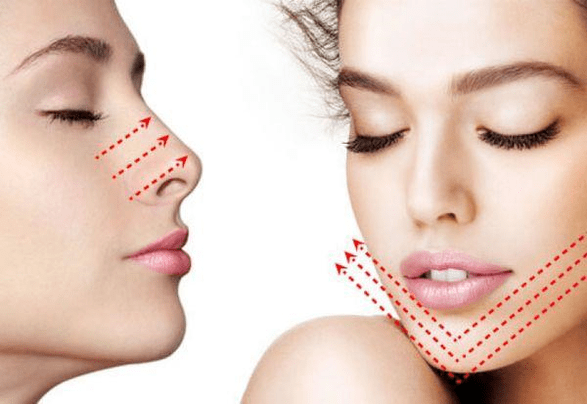
Such a procedure is also used as a temporary measure in the event that a minor patient with a severe disability (due to a fracture or injury) cannot be operated on.
For men
Men prefer a radical approach to modeling with fillers to get rid of mistakes once and for all. Indications for rhinoplasty in men may include:
- frequent sinusitis, chronic nasal congestion;
- injuries that led to deformity of the nose and septum;
- congenital pathologies and deformities in the bone structure of the organ;
- saddle shape, large nostrils, wide bridge of the nose, large length or thickness of the nose;
- respiratory disorders;
- presence of nasty hump.
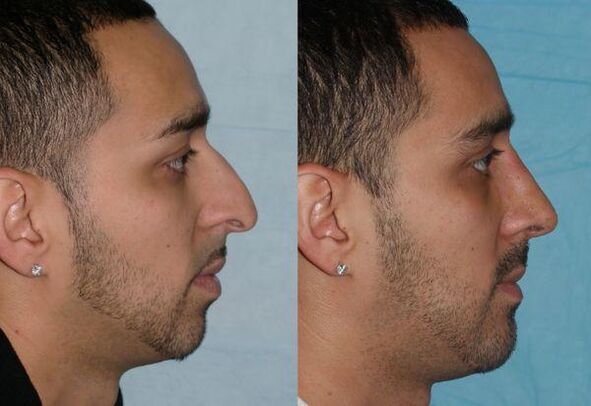
Among women
Any type of intervention can be applied to women. Which surgee to turn to is decided by the surgeon. If small changes need to be made, the aesthetic problem will be solved without the use of a scalpel. The method of injection is often used on the eve of surgery so that a woman can assess what her nose will look like in the future.
We can improve with this procedure
Hump correction
The reduction can be achieved by injecting a filler into the curved portion. To correct the hump, the gel is injected along the entire length of the back of the nose. Hyaluronic acid-absorbed formulations are most commonly used to straighten the nose.
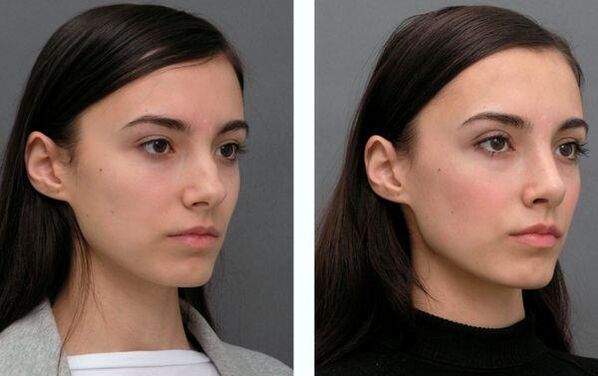
Tip fix
They are performed by injecting fillers into problem areas. Such rhinoplasty is especially sought when there are small pits or depressions in the tip of the nose. The nose of the potato is repaired by bringing filler into its tip, which makes it sharper.
The tip can be lifted by injecting the gel into the columella area of the nose. Visually, this hides the hook tip. In some cases, it is also necessary to inject into the nasal wings to narrow the nostrils slightly.
Repair a broken nose
If the nose is damaged more than once, contouring will not help. In such a situation, only nasal septal surgery is indicated. And most likely a full-fledged reconstruction and aesthetic operation. Reconstruction of both the septum and the external osteochondral skeleton may be required.
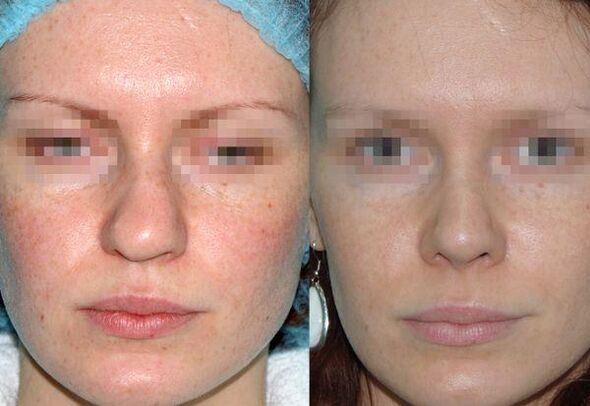
Adjusting the backrest
The curved nasal bridge is impossible to align without surgery. Rhinoplasty with an injection only covers the defect. For example, the nose is corrected (with a low bridge and a raised tip) by injecting fillers over the entire surface of the nasal bridge to the very end.
Wing reduction
Hyaluronic acid gel is used to correct the asymmetry of the nasal wings. In this case, the person skilled in the art must calculate the dose accurately.
The nose becomes thinner and more expressive after rhinoplasty with hormones.
If it is necessary to remove or reduce the asymmetry of the nostrils, fillers are injected into the lower part of the wings of the nose.
How old is the surgery
There must be clear reasons for the operation on the face. A conscientious plastic surgeon will not undertake to correct a minor’s nose if a girl’s or boy’s certain whims serve as a basis.
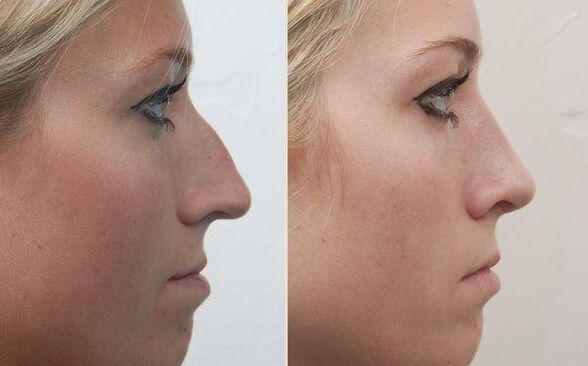
Persons over the age of 18 are allowed to undergo surgery. In extremely rare situations, this condition can be impaired. The minimum age for rhinoplasty in girls is 13-14 years, in boys - 15-16 years.
For medical reasons, a teenager can undergo almost any plastic surgery. However, doctors recommend that you be patient until the beginning of age, when at least 80-90% of the operated organ is formed.
How to prepare for a non-surgical procedure
It is easier to prepare for a non-surgical procedure than classical surgery. Perhaps your doctor will advise you to see a dermatologist to tell you what tests are being done to identify contraindications and limitations.
Following these rules will help reduce your risk of complications:
- You must stop drinking alcohol 10 days before the plastic surgery;
- salicylates increase bleeding, which means that you should stop taking "Aspirin" and other similar medicines one week before the procedure;
- refrain from eating at least 10 hours in advance;
- it is recommended to exclude high physical activity a few days before the injection plastics;
- you need to wash your hair the day before as you cannot bend down and wet your face after the procedure.
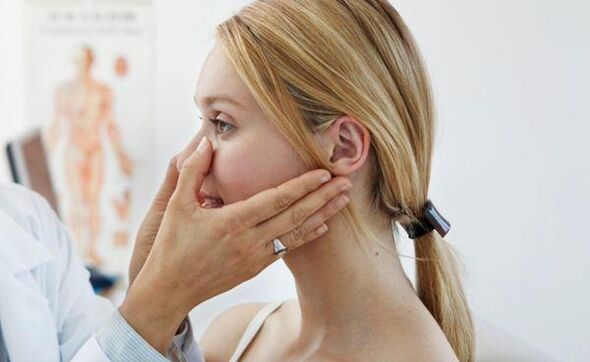
Your doctor will prescribe antihistamines. In case of high temperature, menstruation, respiratory diseases, the procedure should be discontinued until recovery.
Do you need anesthesia
General anesthesia is not required for non-surgical rhinoplasty. Local anesthesia or infiltration anesthesia is used for anesthesia.
Technology implementation
Non-surgical plastic surgery is performed on an outpatient basis, there is no need for hospitalization of patients. After the procedure, the plastic surgeon’s clients go home.
Thorough examination and computer modeling of the future shape of the nose is performed in advance. The average duration of manipulations is 35-60 minutes. The operation is step by step as follows:
- The patient is conscious, only local anesthesia is used. Your doctor will apply a lidocaine-based cream to your nose and surrounding area. During the film, the exposure time is 10-15 minutes.
- After opening the ampoule with the drug and filling the gel into the microchannel, gradually and carefully inject the filler into the designated areas of the nose. If the customer has a desire, you can use a mirror to monitor the progress of the process, which you will keep alone.
- If necessary, the beautician can re-inject the filler.
- The last stage is a light hand massage. Needed for better filler distribution.
The result can be evaluated immediately. The fillers are safe and are completely absorbed within 1. 5 years.
Consequences and contraindications of non-surgical rhinoplasty
Corrections should not be made to women during pregnancy or menstruation. Non-surgical correction is contraindicated in patients with the following diseases:
- acute infectious diseases;
- keloidosis;
- autoimmune pathologies;
- endocrine system pathologies, including diabetes mellitus;
- hemophilia and other blood clotting problems;
- allergy and individual intolerance to the ingredients of the drugs used;
- oncological diseases, tumors of any localization.
What complications may occur
Postoperative complications occur in 10% of cases. They can also occur during surgery (bleeding, cracking of the skin, rupture of the mucous membrane of the cartilage, violation of the integrity of the bone pyramid, fracture of the bone site).
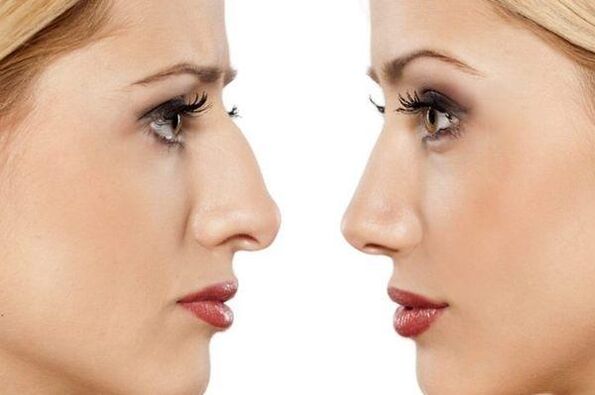
If several cosmetic defects are eliminated during the operation, a number of complications can develop:
- nose bleeding;
- postoperative pigmentation;
- bone callus;
- swelling and hematoma of soft tissues;
- odor loss;
- the appearance of keloid scars;
- difficulty breathing;
- curvature of the nasal septum.
Non-surgical rhinoplasty is not as dangerous, although it is also a difficult procedure in aesthetic surgery. A special splint is then applied to the patient’s nose that fixes the result and protects it from injury.
Redness and swelling of the nose may occur for a few hours after the procedure. These problems will completely disappear within 24 hours. After tightening with the fibers, bruises can develop which disappear completely within a week.
Rare complications include processes that can occur due to the inexperience of the surgeon performing the procedure or the patient’s non-compliance with postoperative rules: displacement of fillers and rupture of fibers placed under the skin. The doctor needs to address the problem urgently.
Caring for your nose after surgery
Rhinoplasty with a laser, hyaluronic acid injections and fillers minimizes the rehabilitation period. You can go home immediately after the nose contouring procedure. The swelling disappears within 1-2 days.
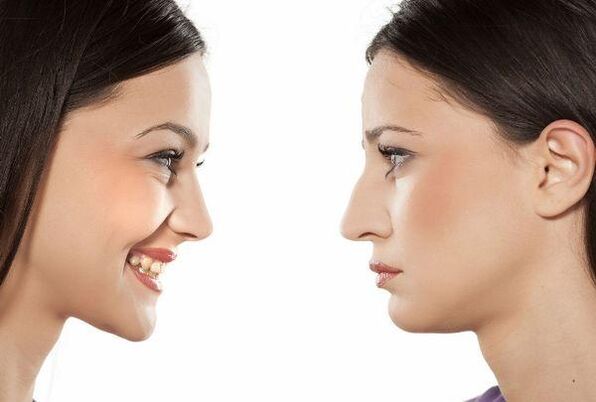
Rehabilitation takes an average of several days (depending on the correction method performed). After the manipulation performed, there are almost no restrictions. You can still go to work, play sports and live a normal life.
In the postoperative period, it is necessary to pay attention to facial expressions: it is not possible to squint, frown. You should not strain your muscles, blow your nose, sneeze and cough for a few hours. Glasses should not be worn for the first 2-3 days of recovery.
There are strict restrictions on visiting swimming areas (lakes, swimming pool, spa, sauna). You also have to give up sunbathing, smoking, priming.
You should not massage the injection site for 2 weeks or perform physiotherapy.
How long does edema last after surgery?
The total post-operative rehabilitation period can take about a year. In the first days, the patient should wear a bandage, bandage, or plaster bandage. The swelling of the face subsides in 1-2 days. After 21 days, the plaster is removed and blood clots from the nose and tampons are removed.
Active recovery will occur in the next 3 months, traces of side effects will subside, but minor changes may occur by the end of the year.
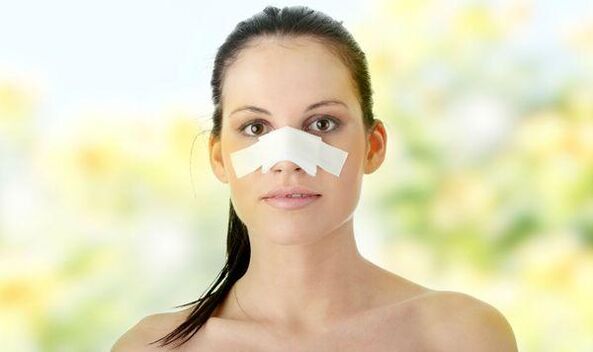
What to do if the operation fails
The result of the operation performed can only be judged after 6 months. Practice shows that 20% of all interventions to correct or eliminate nasal defects are not unique.
If after this time the nose does not reach the desired shape or swelling remains, the operation is considered unsuccessful. In such situations, repeated operations are assigned.
When to repeat the procedure
The effect of non-surgical nasal surgery lasts on average about a year. You can repeat the procedure at any time.
After surgery, repeated (secondary) rhinoplasty can be prescribed at the earliest one year later. Technically, this is a more complex procedure. It is prescribed if the patient is dissatisfied with the result or the previous surgery was unsuccessful (did not give the expected effect).
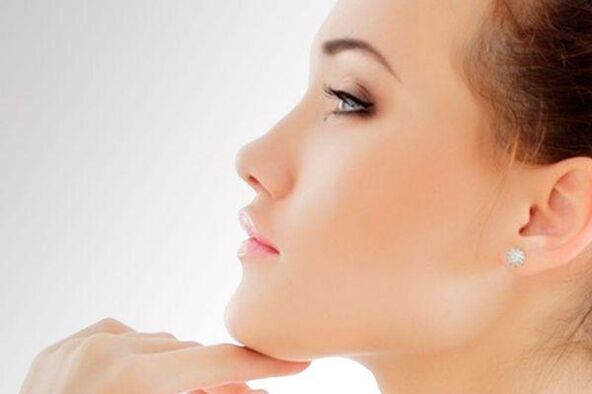
Benefits of non-surgical rhinoplasty
The filling and suturing procedure is not considered a complete alternative to surgery, but it has a number of obvious advantages. The most important are:
- pain relief;
- short rehabilitation period (sometimes missing);
- achieving results quickly;
- reversibility (you can always return the previous form if the result is unsatisfactory).
The method has advantages and disadvantages. It has an extremely low effect on the general condition of the body, does not damage the tissues of the face, then no scars and scars form. However, if administered incorrectly, gel lumps can form under the skin. Their shift leads to a change in the shape of the nose.
After a minimally invasive procedure, there are no stitches, the skin heals better. But there is still a risk of infection and infection.
The low cost makes the procedure available to anyone who wants to improve their appearance. However, possible complications require the treatment of the clinic to be treated with extreme caution.Most often, unsuccessful cosmetic interventions occur after visiting non-specialized salons and doctors who are not properly qualified.The final decision should only be made after studying the master’s previous work and evaluating the clinic.






















